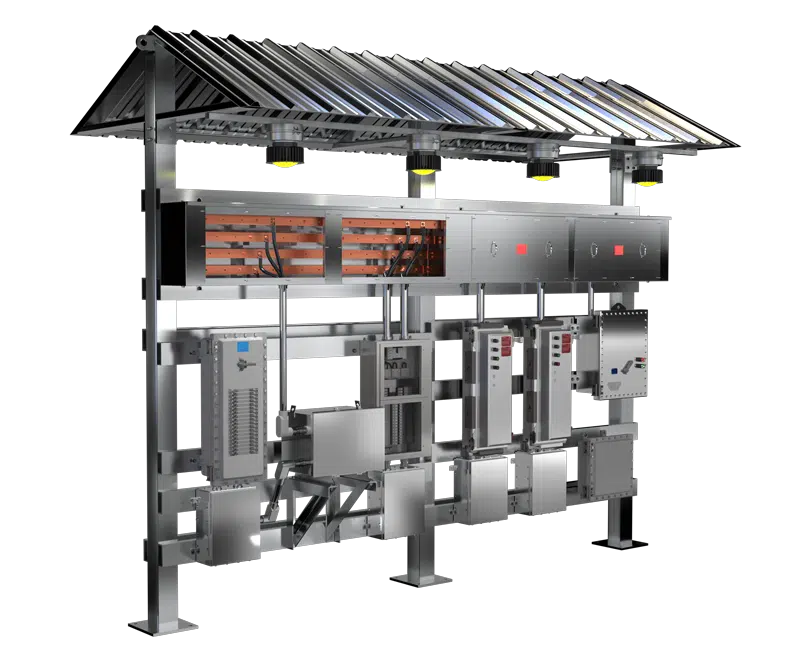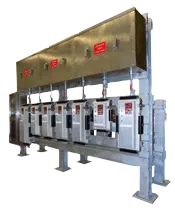
When it comes to hazardous location (HazLoc) environments, safety considerations must begin at the earliest stages of electrical design and extend throughout the operational life of the equipment. HazLoc switchracks, prevalent in industries such as oil and gas, chemical processing, and petrochemical plants, demand rigorous adherence to safety standards to prevent incidents that could cause severe injuries or operational downtime. Leveraging critical insights from IEEE guidelines and practical expertise demonstrated by Spike Electric Controls, this blog focuses on three primary safety considerations: arc flash hazards, grounding integrity, and personal protective equipment (PPE).
Understanding Arc Flash Hazards
Arc flash incidents represent a significant hazard around electrical equipment, particularly in hazardous environments. An arc flash is a rapid release of energy due to an electrical fault, which results in intense heat, bright light, explosive sound, and potentially harmful pressure waves. IEEE standards emphasize the importance of minimizing arc flash risks through careful design and ongoing risk management.
Spike Electric Controls integrates comprehensive arc flash mitigation strategies into their switchrack designs. Engineering practices, including selecting appropriate protective devices with quick fault-clearing capabilities, reduce exposure to dangerous incident energies. These proactive design considerations significantly lower the potential severity of arc flash incidents.
Grounding Systems: The Foundation of Electrical Safety
Grounding is another crucial aspect of electrical safety in HazLoc environments. Proper grounding provides a controlled path for fault currents, ensuring rapid clearing of electrical faults and preventing dangerous voltage potentials on equipment frames or enclosures. IEEE guidelines stress meticulous attention to grounding practices, clearly outlining requirements for grounding system integrity, continuity, and periodic inspections.
Spike Electric meticulously follows these guidelines by implementing robust grounding systems tailored specifically for hazardous locations. Structural grounding components, including continuous grounding loops and dedicated grounding bars, ensure each piece of equipment remains at a safe electrical potential. Regular inspections and testing verify grounding system effectiveness, safeguarding personnel and equipment from potential electrical hazards.
Importance of Personal Protective Equipment (PPE)
Personal protective equipment is a critical line of defense in mitigating risks associated with electrical operations around HazLoc switchracks. IEEE and NFPA 70E standards provide clear directives regarding PPE use, specifying equipment types, required protection levels, and procedures for use based on hazard assessments and risk analysis.
PPE for electrical work around switchracks typically includes:
- Flame-resistant clothing (coveralls, jackets)
- Arc-rated face shields and hoods
- Safety glasses or goggles
- Voltage-rated gloves
- Hearing protection
- Hard hats
Spike Electric emphasizes rigorous adherence to PPE protocols, providing training and detailed documentation on proper selection, maintenance, and use. This comprehensive approach ensures personnel understand PPE requirements and utilize equipment correctly during both routine operations and emergency responses.
Design Strategies to Enhance Safety
Proactively managing safety begins with thoughtful switchrack design. IEEE highlights specific design strategies aimed at reducing electrical hazards:
- Component Selection: Selecting high-quality, properly rated electrical components minimizes risk of equipment failures leading to electrical faults.
- Arc-Flash Reduction Techniques: Utilizing current-limiting devices and high-resistance grounding systems significantly reduces incident energy levels, enhancing personnel safety.
- Accessible Design for Safe Maintenance: Ensuring components are safely accessible simplifies routine inspections and maintenance, reducing the risk of accidental exposure to live components.
Spike Electric incorporates these safety strategies consistently into their switchrack designs, reflecting their commitment to comprehensive electrical safety from concept through operation.
Regular Safety Training and Awareness
Beyond technical design considerations, ongoing training and safety awareness are essential for personnel working around HazLoc switchracks. IEEE standards, along with NFPA 70E, mandate regular electrical safety training covering arc flash hazards, proper use of PPE, emergency procedures, and routine safety practices.
Spike Electric actively supports clients by providing tailored safety training sessions, detailed safety guidelines, and regular refresher training to reinforce best practices. Cultivating a robust safety culture ensures all personnel remain vigilant and knowledgeable about potential electrical hazards and protective measures.
Emergency Response and Incident Management
Even with rigorous preventive measures, preparedness for potential emergencies remains essential. IEEE guidelines advise clear, documented procedures for handling electrical incidents, including immediate response actions, PPE protocols during emergencies, and safe equipment isolation procedures.
Spike Electric integrates these considerations into their comprehensive emergency management strategies, providing clearly documented response protocols and procedures. Regular drills and training sessions reinforce emergency preparedness, ensuring rapid, effective responses during critical incidents.
Routine Inspection and Safety Audits
Continuous evaluation through routine inspections and safety audits helps identify potential hazards before they escalate into serious incidents. IEEE recommends regular inspections of grounding systems, protective device settings, and PPE availability and condition, alongside comprehensive safety audits.
Spike Electric Controls advocates for regular scheduled inspections, detailed maintenance protocols, and periodic safety audits. These systematic evaluations identify risks early, allowing timely corrective actions and ensuring sustained safety standards.
Conclusion: Prioritizing Safety Through Design
Safety in hazardous environments demands comprehensive, proactive strategies beginning at the design stage and continuing throughout the operational lifecycle. By carefully addressing critical areas like arc flash mitigation, grounding system integrity, and rigorous PPE usage, engineers and operators significantly enhance electrical safety.
Through adherence to IEEE guidelines and leveraging Spike Electric Controls’ extensive expertise, facilities can establish robust safety frameworks that protect personnel, assets, and operational continuity. Prioritizing safety from initial design through routine inspections and ongoing personnel training ensures not only compliance with safety standards but also a safer working environment for everyone involved.


